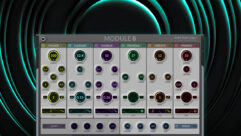In shape
Nov 1, 1998 12:00 PM,
Doug Green and Bruce Borgerson
As far as sound contractors are concerned, the fitness industry is apeculiar world. Cutting-edge fitness chains have specific and demandingrequirements for audio systems, and many of the staff who handle theequipment run at high energy levels-even frantic at times. Consequently,designing a system for tomorrow’s fitness centers involves creatingsomething akin to a multiroom, high-quality dance club system for use in awar zone.
System requirements for fitness centers have evolved rapidly over just thelast five years. When Commercial Sound Works, Los Angeles, first becameinvolved with the industry in the early 1990s, we were frequently called into rescue systems that were basically little more than hi-fi rigs with afew M.I.-grade equipment add-ons. This was at the peak of the spinningcraze when rooms were filled with a dozen or more people pumping full boreon chain-drive stationary bikes. High-energy dance music struggled to keepabove the mechanical din with an instructor shouting through a mic, pushingthe system over the edge. Little wonder that the instructor’s voice wasinaudible and the amp was thermalling out after 20 minutes.
After we successfully solved the problems at one of these clubs, wordspread among fitness instructors in southern California about our newsystem. Soon, we found our services in demand, and we eventually installednew systems or reworked old systems at more than a dozen fitness clubs inthe area. Throughout the process, we evolved a number of design parametersthat prepared us for a bid on the new Crunch Club on Sunset Boulevard.
Launched in 1989 by former securities trader Doug Levine, Crunch startedwith one small fitness studio in New York’s East Village. Levine has sinceexpanded Crunch into five New York locations along with the one inHollywood, CA, and a new club recently opened in San Francisco. Plans formore locations are underway.
Crunch is a far cry from your average YMCA workout facility. Depending onthe location and time of day, you will find hip-hop aerobics (gospelaerobics with a live band on Sundays), yoga on stationary bicycles, co-edwrestling, indoor rollerblade circuits, Afro-Brazilian cardio (with livedrummers) or a sealed hypoxic workout room with air sucked out to mirrorthe effects of a 10,000 foot (3,048 m) altitude. All Crunch locations havetwo elements in common. The first is a good-humored, non-judgmentalattitude. The second is plenty of music at the right energy level and theright feel for the activity at hand.
As Crunch went through its initial phase of rapid expansion in New York,each gym’s audio and video system was assembled and/or upgraded on apiecemeal basis. Budgets were generous enough to provide quality equipment,but there was no central coordination or grand design to assure consistentresults from location to location. When Crunch established the Hollywoodlocation, Commercial Sound Works was contracted to design, supply andinstall the audio system in early 1997. Our first Crunch system was largelya refinement of the earlier fitness systems we had done, although it wasexpanded in scope to accommodate the size of the club and the requirementsfor multiple music programs. The design and execution of the job provedsuccessful to the point where it eventually led to the redesign andretrofitting of the New York clubs, system design and installation at thenew San Francisco location, and work at future locations. Our experienceover the last 18 months has helped us develop a set of design criteria forlarger, high-energy, quality-conscious fitness centers.
Acoustical considerationsBe prepared; most fitness facilities give little consideration toacoustical qualities. Surfaces are likely to be hard and parallel, andquite often aerobics rooms (at Crunch, for example) are enclosed almostentirely by glass. The ambient noise problems generated by the fitnessequipment are obvious, but you must often deal with other noise sources. Atthe 59th Street Crunch in New York, we have naked HVAC ducts at 4 feet (1.2m) above head level running the full length of the room. At LafayetteStreet, subway trains rumble underneath for about 20 seconds at a time.
The important point here is to investigate the environment carefully,inquire about the use of each room if equipment has yet to be installed,and beware of under-specifying. Mostfitness clubs following the Crunch moldwill have a distributed system with two to six zones with one or moreaerobics rooms and their individual systems. At Crunch, the distributedsystem zones carry one of two different audio programs-a high-energy musicprogram for the workout areas and a mellower program (jazz/pop) for thedressing room and lobby areas. All music for the distributed systems iscustom programmed and played back on the digital MiniDisc format.
Distributed systemsAlthough aerobic systems pose their peculiar difficulties, the distributedsystems require the most attention to detail in design and installation. Incontemporary fitness clubs, the systems must provide forward, present andfull-fidelity reproduction without being overbearing in any part of theroom. What will not work is placing large loudspeakers in the corners andturning them up to fill the room. The big challenge is to get even coverageand plenty of power to the bass without resorting to ungainly boxes thatwould clash with the decor of the room. The key elements in selectingloudspeakers are wide bandwidth response, even coverage patterns and goodbass response. The loudspeakers also need to be compact enough to allowtucking away in open ceilings and offer flexible mounting for orientationat any angle-either singly, in pairs or in clusters.
Among the most important elements in our successful Crunch club designs arethe JBL Professional C28 loudspeakers used as the primary distributedsystem loudspeaker. We have modified other equipment to suit particularcircumstances, but these loudspeakers have become the foundation of theCrunch sound. In most installations, we mount them in threes on the MTC-28Hbracket for 360 degrees. When suspended in the right place at the properheight and angle, the C28s are especially effective. They blend smoothlyand lend a consistent energy to the room. They also deliver a dance-clubvibe at levels that allow overlay of an instructor’s voice. When we firstfired them up at the Sunset Club, the Crunch people were thrilled by thesound, and we have stuck with that approach ever since.
At our first installation in California, we ran the C28 systems on 70 Vlines, and results were more than adequate for the acoustic environment.For more intense environments demanding greater bass response, as we foundin New York, you may want to consider wiring some or all loudspeakers fordirect drive. With the C28s, this can often give you more power on thebottom without adding subwoofers. To make this work, our senior designengineer, Mark Blasquez, came up with a series-parallel wiring scheme thatdelivered the desired results and saved the client money on transformers,subwoofers and amp capacity.
Reliability is the key criterion in amp selection; extended bass is a closesecond. We had good results with QSC amps in our 70 V distributed systemsat Crunch, but then switched to Crest for the direct drive systems in NewYork because they exhibited better bass definition.
Most of our main distributed systems use an Aphex aural exciter along witha Behringer compressor/limiter for system protection. Music sources areusually Technics SLPD CD changers, Sony MiniDisc players and Denon or JVCpitch-control tape decks. We specify a Mackie VLZ-1202 mixer because thebusing facilities afford easy creation of two separate mono mixes forrouting via zones to different parts of the facility. Each area is wired asa separate zone with Behringer or Rane units for control of zone levels andEQ.
Regarding overall system design, it is important to integrate flexibilityfrom the outset. In our case, we have found the people at Crunch to becreative and constantly looking for new ways to use audio and video toenhance the exercise experience. Systems must be designed to accommodatesuch changes with a minimum of added expense or hassle. In this respect, weare investigating some of the newer, software-based processing anddistribution devices, although we will not specify them until issues ofreliability and unauthorized tampering can be resolved.
Front-line dutyThe distributed systems usually have a low level of operator involvement.Once the levels are set, operators need only change source program and makeminor adjustments in levels. With the aerobics systems, however, issues ofoperator interface and reliability move to the forefront. There is notypical aerobics instructor when it comes to technical knowledge orattitude. Some know the basics of mixers, mics and processing, and treatthe equipment with care. Others do not, and you have to design youraerobics front end with these people in mind.
It is a harsh environment. In the heat of a high-energy workout, controlsmay get slammed hard. Also, some instructors may want access to controlsthat they should not tamper with and jimmy the security covers off mixers.Mixers take the brunt of the abuse, and here we sometimes have to weighoperator preferences with reliability. In New York, for example, manyinstructors prefer the Vestax deejay-style mixer. At some clubs these willsurvive intact for a year or more; at others, they will be renderedunusable in three weeks with knobs broken off and shafts bent.
Before specifying any piece of equipment for the front end of an aerobicssystem, evaluate it accordingly. Make sure it can take hard hits and fluidswith relative immunity. Also, it is a good idea to forestall undesiredtampering by installing security covers (we do some custom ones that allowaccess to certain mixer controls and not others) and to place a prominentsticker on the rack with the name and phone number of one of our staffmembers. It is easier to answer a question over the phone and preventtrouble than it is to make a service call after the damage is done. That isparticularly true in our case, because we are in Los Angeles, and mostCrunch installations are in New York. Fortunately, the time difference putspeak club activity in our regular business hours.
Tampering and theft protectionFor both distributed and aerobics systems, your design must addressvisibility and accessibility. Fitness systems are installed in anenvironment of constant noise, bustling activity and public access thatcannot always be tightly controlled. Loudspeaker system brackets, forexample, must be securely bolted in place, and the loudspeaker mountingsystem should use a special tool (as with the JBL Invisiball system) thatprevents easy dismounting.
Crunch management likes placing racks for the distributed system in publicview, although equipment is usually removed from immediate public access bya desk or low partition. With this open display, you need to secureeverything tightly in the rack and minimize access. We put security coversover all the processing gear so somebody cannot change a crossover pointwhen he intends to pump up the volume. Such possibilities should beconsidered in equipment selection as well. For example, we now specify theCrest VS series amps because, among other reasons, they have level controlson the rear panel. We have designed special security covers for the Mackiemixers that cover everything except the volume knobs.
Power protection and conditioning is another important dose of preventivemedicine. Standard Crunch systems use Furman or dbx Professional powerconditioners, which give us one master switch per rack to simplifyoperation.
Finally, perhaps the most important ingredient in the successful design ofa fitness system has nothing to do directly with equipment or installation.It is the people factor. This is particularly true if, as in our case, youare installing your systems 3,000 miles (4,830 km) from home.
Most larger fitness centers have an in-house technical staff of some kindwith one person on duty during most business hours, but this person’sconcerns (and expertise) will be primarily oriented toward the fitnessequipment and only secondarily with the audio equipment. Nevertheless,these people are an invaluable resource, and you should cultivate theirfavor. They will be your first line of defense against a problem’smushrooming out ofcontrol. You can best assist them by designing a systemrelatively free of recurring problems and failures; with fewer problemsdemanding attention, they can take better care of those that do crop up.
At Commercial Sound Works, we are convinced that Crunch is the leading edgeof what will be the redefined fitness industry of the 21st century. Crunchis too successful for others not to follow their lead. That means goldenopportunities for contractors who want to target the growing fitness systemmarket, and latching on to the fitness boom has side benefits as well. Inour case, it has forced us to become more innovative in our system designsand to work harder in equipment evaluation in order to find componentssuitable to the peculiar rigors of a fitness center environment. We havedeveloped strong relationships with key suppliers who have proven thattheir products can withstand the punishment and stand up in thisenvironment.
Also, Crunch presented us an opportunity to go national and move ourcompany to a higher level of prominence and profitability. Crunchmanagement has provided fertile ground for trying out new, cutting-edgesystem designs, and their example of quality and creativity has inspiredour work as well. Ultimately, it is not just about the fitness industry.For Crunch, we needed to learn how to execute successful, well-designed andwell-tuned systems far from home.










